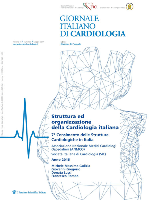
Giornale Italiano di Cardiologia
Scope & Guideline
Innovating Cardiac Care Through Rigorous Research
Introduction
Aims and Scopes
- Clinical Cardiovascular Research:
The journal publishes original research articles that explore various aspects of cardiovascular diseases, including their pathophysiology, clinical presentation, and management strategies. - Guidelines and Recommendations:
It provides updates on clinical practice guidelines from relevant cardiology societies, ensuring that practitioners are informed about the latest standards in cardiovascular care. - Interventional Cardiology:
The journal features studies and reviews on interventional procedures, including advancements in catheter-based therapies, surgical techniques, and device implantation. - Preventive Cardiology:
There is a strong focus on prevention strategies for cardiovascular diseases, including the exploration of risk factors, lifestyle modifications, and pharmacological interventions. - Cardio-Oncology:
The Giornale covers the intersection of cardiology and oncology, discussing the cardiovascular implications of cancer treatments and the management of patients with concurrent cardiac and oncological conditions. - Emerging Technologies and Innovations:
The journal highlights the role of new technologies in cardiology, such as telemedicine, digital health solutions, and advancements in imaging techniques. - Patient-Centered Care:
Emphasizing shared decision-making, the journal promotes approaches that prioritize patient preferences and improve adherence to treatment plans.
Trending and Emerging
- Telemedicine and Digital Health:
There is a significant increase in articles discussing the application of telemedicine and digital health technologies in cardiology, especially in the context of the COVID-19 pandemic and its aftermath. - Cardio-Oncology:
The intersection of cardiology and oncology is gaining traction, with more studies addressing the cardiovascular effects of cancer therapies and the management of patients with concurrent heart conditions. - Heart Failure Management:
Emerging themes in heart failure management, particularly focusing on new pharmacological agents and devices, are increasingly prominent in recent publications. - Patient-Centered Approaches:
There is a notable trend towards patient-centered care models, emphasizing shared decision-making, quality of life, and adherence to treatment in cardiology. - Chronic Disease Management:
A growing body of research is focusing on the management of chronic diseases, particularly the integration of cardiovascular care with other chronic conditions, such as diabetes and renal disease. - Novel Antithrombotic Therapies:
Recent studies are exploring the effectiveness and safety of novel antithrombotic therapies, reflecting advancements in anticoagulation strategies for various cardiovascular conditions. - Public Health and Cardiovascular Epidemiology:
An increasing number of publications are addressing the public health implications of cardiovascular diseases, including epidemiological studies that inform prevention strategies.
Declining or Waning
- Traditional Pharmacological Treatments:
There is a noticeable decrease in publications focusing solely on traditional pharmacological treatments for cardiovascular diseases as the field moves towards more personalized and innovative therapeutic strategies. - Basic Science Research:
Research articles centered on basic science and underlying mechanisms of cardiovascular diseases have become less frequent, possibly overshadowed by clinical and translational research. - Invasive Procedures without Comprehensive Follow-up:
The focus on invasive procedures without comprehensive follow-up studies has declined, reflecting a shift towards evidence-based practice that emphasizes long-term outcomes and patient safety. - Age-Related Cardiovascular Research:
Research specifically targeting age-related cardiovascular conditions has seen reduced attention, as the journal shifts towards broader themes that encompass diverse patient populations. - Single-Center Studies:
There is a waning interest in single-center studies, with a preference for multi-center or collaborative research efforts that provide more generalizable results.
Similar Journals

Nepalese Heart Journal
Connecting Researchers and Clinicians for a Healthier FutureNepalese Heart Journal, published by the CARDIAC SOC NEPAL, serves as a premier platform for disseminating knowledge in the field of cardiology and cardiovascular health. With an ISSN of 2091-2978, this journal aims to bridge the gap between researchers, clinicians, and academicians by presenting high-quality, peer-reviewed articles that address clinical practices, innovative research, and emerging trends in heart disease management, especially within the context of Nepal and the surrounding region. Although it operates under a traditional publishing model, its commitment to excellence aids in reinforcing the scientific discourse in an area critical to public health. The journal is a valuable resource for professionals and students alike who are focused on advancing their understanding of cardiology and its implications for health policy and practice. Exploring the intersections of local challenges and global advancements in heart health, the Nepalese Heart Journal is poised to contribute meaningfully to the evolving landscape of cardiovascular research.
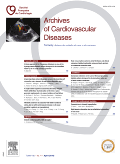
Archives of Cardiovascular Diseases
Pioneering research and collaboration in cardiology.The Archives of Cardiovascular Diseases, published by Elsevier Masson, stands as a leading journal in the field of cardiology and cardiovascular medicine, with an impressive impact factor that underscores its relevance and influence. This esteemed journal, recognized in the Q2 category for both cardiology and miscellaneous medicine, aims to disseminate groundbreaking research, innovative methodologies, and clinical advancements that can shape the future of cardiovascular health. With its diverse array of open access options, researchers and students alike have the ability to engage with high-quality content, ensuring that cutting-edge findings are accessible globally. Since its inception in 2008, the journal has actively contributed to the advancement of knowledge in cardiovascular diseases, fostering collaboration among clinicians, researchers, and educators. Headquartered in Paris, France, Archives of Cardiovascular Diseases remains committed to enhancing our understanding of cardiovascular health and improving patient outcomes worldwide.

Journal fur Kardiologie
Unveiling the Latest in Cardiac Health Research.The Journal fur Kardiologie, published by KRAUSE & PACHERNEGG GMBH, is a pivotal resource in the field of Cardiology and Cardiovascular Medicine. With an ISSN of 1024-0098 and an E-ISSN of 1680-936X, this journal has played a significant role in disseminating valuable research and clinical studies from 1998 until its coverage discontinuation in Scopus in 2017. Despite its Scopus rank being relatively low at #316/324 in its category, it continues to serve as a platform for emerging cardiology research. The journal’s scope encompasses various aspects of cardiovascular health, providing insights that are crucial for researchers, professionals, and students alike seeking to advance their knowledge and practice in cardiology. While the journal is not open access, its contributions to the field are essential for those looking to stay informed about the latest developments in cardiovascular medicine.
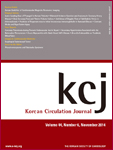
Korean Circulation Journal
Fostering Evidence-Based Practices in Cardiovascular Care.Korean Circulation Journal, published by the Korean Society of Cardiology, has established itself as a prominent platform for disseminating research in the fields of Cardiology and Cardiovascular Medicine. With an ISSN of 1738-5520 and an E-ISSN of 1738-5555, this journal has been at the forefront of cardiovascular science since its inception in 2006 and is projected to continue until 2024. The journal's commitment to quality is reflected in its 2023 category quartiles, ranking in the second quartile (Q2) for both Cardiology and Internal Medicine, as well as its commendable Scopus rankings within the respective fields. Located in South Korea, the journal aims to bridge the gap between cutting-edge research and practical applications, serving as an invaluable resource for researchers, healthcare professionals, and students keen on advancing their understanding of cardiovascular health. Although currently not an open-access journal, it provides a wealth of knowledge that encourages evidence-based practice in clinical settings.

Cardiology and Therapy
Leading the way in cardiology research and innovation.Cardiology and Therapy, published by SPRINGER LONDON LTD, is a leading open-access journal dedicated to advancing the field of cardiology and cardiovascular medicine. With an ISSN of 2193-8261 and an E-ISSN of 2193-6544, this esteemed journal has been at the forefront of disseminating high-quality research since its inception in 2012. It has achieved an impressive Q1 ranking in the 2023 Cardiology and Cardiovascular Medicine category, reflecting its commitment to excellence and relevance in the field. Spanning a wide array of topics—from clinical studies to cutting-edge therapeutic interventions—the journal aims to foster knowledge exchange among researchers, clinicians, and healthcare professionals. In addition, its position in the 72nd percentile of Scopus rankings underscores its global impact and contribution to the cardiovascular research community. With open access options, Cardiology and Therapy ensures that its content is widely accessible, promoting the sharing of vital findings that can influence clinical practice and improve patient outcomes.
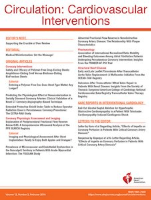
Circulation-Cardiovascular Interventions
Advancing Cardiovascular Knowledge, One Intervention at a Time.Circulation-Cardiovascular Interventions, published by LIPPINCOTT WILLIAMS & WILKINS, is a premier journal in the field of cardiology and cardiovascular medicine, recognized for its commitment to advancing the understanding and treatment of cardiovascular diseases. With a robust Impact Factor and ranking in the top 10% of its category, it serves as an essential resource for researchers, clinicians, and students seeking to stay at the forefront of cardiovascular intervention developments. This esteemed journal covers a range of topics, including innovative therapeutic strategies, cutting-edge clinical trials, and comprehensive reviews that inform clinical practice and influence guidelines. Since its inception in 2008, and extending through 2024, Circulation-Cardiovascular Interventions has published pivotal research that shapes the landscape of cardiovascular care in the United States and beyond. Its commitment to high-quality publications makes it an invaluable platform for sharing knowledge and fostering collaboration within the global medical community.
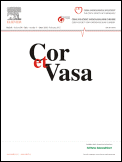
COR ET VASA
Innovating cardiovascular care through research and dialogue.COR ET VASA is a prominent peer-reviewed journal in the field of cardiology and cardiovascular medicine, published by the Czech Society of Cardiology and Czech Society of Cardiovascular Surgery. Established in 1961, and continuing its legacy from 2006 to 2024, this journal serves as an essential platform for disseminating significant research findings, clinical studies, and innovative treatments in cardiovascular health. While currently positioned in the Q4 quartile, the journal aims to enhance its impact by fostering knowledge sharing among researchers, clinicians, and students alike. The journal, with its publication in Czech Republic, provides a unique perspective to the European cardiovascular community, allowing for invaluable insights and discourse. Researchers are encouraged to submit their manuscripts and contribute to the growing body of knowledge in this critical area, although it should be noted that COR ET VASA does not offer open access options at this time. As the field of cardiovascular medicine evolves, COR ET VASA remains committed to addressing the latest challenges and advancements, nurturing a rich dialogue within the community.
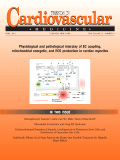
TRENDS IN CARDIOVASCULAR MEDICINE
Connecting Research with Real-World ImpactTRENDS IN CARDIOVASCULAR MEDICINE, published by Elsevier Science London, stands at the forefront of the cardiology field, with a commendable Q1 ranking in the category of Cardiology and Cardiovascular Medicine. Since its inception in 1991, this esteemed journal has provided a vital platform for disseminating cutting-edge research and innovative clinical practices, reflecting the dynamic developments in cardiovascular health. With an impact factor positioning it among the top 3% in its category, TRENDS IN CARDIOVASCULAR MEDICINE is essential reading for researchers, healthcare professionals, and students pursuing the latest advancements and evidence-based approaches in cardiology. Although this journal does not currently operate under an open-access model, its rich array of content encompasses a variety of topics from clinical studies to reviews, ensuring readers stay informed on the pivotal trends that shape cardiovascular medicine. This commitment to excellence underscores the journal's role as a premier resource for anyone dedicated to improving cardiovascular health.
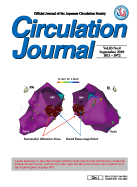
CIRCULATION JOURNAL
Exploring the Frontiers of Heart Health Research.CIRCULATION JOURNAL, published by the Japanese Circulation Society, stands as a premier platform for cutting-edge research in the fields of Cardiology and Cardiovascular Medicine. With an impressive impact factor placing it in the Q1 quartile for both cardiology and general medicine, this journal is essential for researchers and practitioners seeking to stay at the forefront of cardiovascular science. The journal's accessible open access options ensure that groundbreaking studies are widely disseminated, reflecting its commitment to advancing medical knowledge and improving patient care. Since its inception in 1996, CIRCULATION JOURNAL has fostered a global dialogue on vital cardiovascular issues, making it a vital resource for academics, healthcare professionals, and students alike. With its base in Tokyo, Japan, the journal not only highlights regional advancements but also contributes significantly to the global medical community.

ARCHIVOS DE CARDIOLOGIA DE MEXICO
Advancing cardiovascular knowledge for a healthier tomorrow.ARCHIVOS DE CARDIOLOGIA DE MEXICO is a premier open-access journal dedicated to advancing research and clinical practice in the field of cardiology and cardiovascular medicine. Published by the Instituto Nacional de Cardiología Ignacio Chávez since 2001, this journal offers a valuable platform for the dissemination of high-quality, peer-reviewed articles that span diverse aspects of cardiovascular health. With its current categorization in the fourth quartile (Q4) of cardiology journals and a Scopus rank of #319 out of 387, ARCHIVOS DE CARDIOLOGIA DE MEXICO is positioned within the dynamic landscape of cardiovascular research, presenting opportunities for both emerging and established voices in the field. It aims to promote discussion and innovation across various topics in cardiology, making it a crucial resource for researchers, healthcare professionals, and students keen on keeping abreast of developments in cardiovascular science. Accessible online since 2009, this journal fosters collaboration and knowledge sharing among specialists worldwide, establishing itself as a significant contributor to the global discourse on heart health.